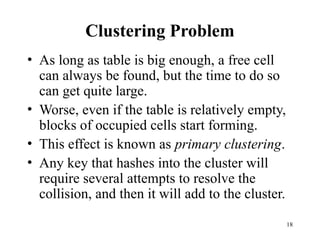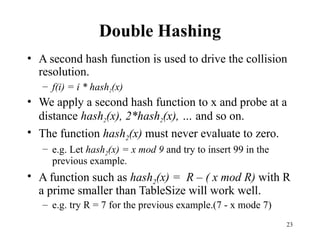Hashing Techniques in Data Strucures and Algorithm
- 1. 1 Hashing
- 2. 2 General Idea • The ideal hash table structure is merely an array of some fixed size, containing the items. • A stored item needs to have a data member, called key, that will be used in computing the index value for the item. – Key could be an integer, a string, etc – e.g. a name or Id that is a part of a large employee structure • The size of the array is TableSize. • The items that are stored in the hash table are indexed by values from 0 to TableSize – 1. • Each key is mapped into some number in the range 0 to TableSize – 1. • The mapping is called a hash function.
- 3. 3 Example Hash Function mary 28200 dave 27500 phil 31250 john 25000 Items Hash Table key key 0 1 2 3 4 5 6 7 8 9 mary 28200 dave 27500 phil 31250 john 25000
- 4. 4 Hash Function • The hash function: – must be simple to compute. – must distribute the keys evenly among the cells. • If we know which keys will occur in advance we can write perfect hash functions, but we don’t.
- 5. 5 Hash function Problems: • Keys may not be numeric. • Number of possible keys is much larger than the space available in table. • Different keys may map into same location – Hash function is not one-to-one => collision. – If there are too many collisions, the performance of the hash table will suffer dramatically.
- 6. 6 Hash Functions • If the input keys are integers then simply Key mod TableSize is a general strategy. – Unless key happens to have some undesirable properties. (e.g. all keys end in 0 and we use mod 10) • If the keys are strings, hash function needs more care. – First convert it into a numeric value.
- 7. 7 Some methods • Truncation: – e.g. 123456789 map to a table of 1000 addresses by picking 3 digits of the key. • Folding: – e.g. 123|456|789: add them and take mod. • Key mod N: – N is the size of the table, better if it is prime. • Squaring: – Square the key and then truncate • Radix conversion: – e.g. 1 2 3 4 treat it to be base 11, truncate if necessary.
- 8. 8 Collision Resolution • If, when an element is inserted, it hashes to the same value as an already inserted element, then we have a collision and need to resolve it. • There are several methods for dealing with this: – Separate chaining – Open addressing • Linear Probing • Quadratic Probing • Double Hashing
- 9. 9 Separate Chaining • The idea is to keep a list of all elements that hash to the same value. – The array elements are pointers to the first nodes of the lists. – A new item is inserted to the front of the list. • Advantages: – Better space utilization for large items. – Simple collision handling: searching linked list. – Overflow: we can store more items than the hash table size. – Deletion is quick and easy: deletion from the linked list.
- 10. 10 Example 0 1 2 3 4 5 6 7 8 9 0 81 1 64 4 25 36 16 49 9 Keys: 0, 1, 4, 9, 16, 25, 36, 49, 64, 81 hash(key) = key % 10.
- 11. 11 Operations • Initialization: all entries are set to NULL • Find: – locate the cell using hash function. – sequential search on the linked list in that cell. • Insertion: – Locate the cell using hash function. – (If the item does not exist) insert it as the first item in the list. • Deletion: – Locate the cell using hash function. – Delete the item from the linked list.
- 13. 13 Collision Resolution with Open Addressing • Separate chaining has the disadvantage of using linked lists. – Requires the implementation of a second data structure. • In an open addressing hashing system, all the data go inside the table. – Thus, a bigger table is needed. • Generally the load factor should be below 0.5. – If a collision occurs, alternative cells are tried until an empty cell is found.
- 14. 14 Open Addressing • More formally: – Cells h0(x), h1(x), h2(x), …are tried in succession where hi(x) = (hash(x) + f(i)) mod TableSize, with f(0) = 0. – The function f is the collision resolution strategy. • There are three common collision resolution strategies: – Linear Probing – Quadratic probing – Double hashing
- 15. 15 Linear Probing • In linear probing, collisions are resolved by sequentially scanning an array (with wraparound) until an empty cell is found. – i.e. f is a linear function of i, typically f(i)= i. • Example: – Insert items with keys: 89, 18, 49, 58, 9 into an empty hash table. – Table size is 10. – Hash function is hash(x) = x mod 10. • f(i) = i;
- 16. 16 Figure 20.4 Linear probing hash table after each insertion
- 17. 17 Find and Delete • The find algorithm follows the same probe sequence as the insert algorithm. – A find for 58 would involve 4 probes. – A find for 19 would involve 5 probes. • We must use lazy deletion (i.e. marking items as deleted) – Standard deletion (i.e. physically removing the item) cannot be performed. – e.g. remove 89 from hash table.
- 18. 18 Clustering Problem • As long as table is big enough, a free cell can always be found, but the time to do so can get quite large. • Worse, even if the table is relatively empty, blocks of occupied cells start forming. • This effect is known as primary clustering. • Any key that hashes into the cluster will require several attempts to resolve the collision, and then it will add to the cluster.
- 19. 19 Linear Probing – Analysis -- Example • What is the average number of probes for a successful search and an unsuccessful search for this hash table? – Hash Function: h(x) = x mod 11 Successful Search: – 20: 9 -- 30: 8 -- 2 : 2 -- 13: 2, 3 -- 25: 3,4 – 24: 2,3,4,5 -- 10: 10 -- 9: 9,10, 0 Avg. Probe for SS = (1+1+1+2+2+4+1+3)/8=15/8 Unsuccessful Search: – We assume that the hash function uniformly distributes the keys. – 0: 0,1 -- 1: 1 -- 2: 2,3,4,5,6 -- 3: 3,4,5,6 – 4: 4,5,6 -- 5: 5,6 -- 6: 6 -- 7: 7 -- 8: 8,9,10,0,1 – 9: 9,10,0,1 -- 10: 10,0,1 Avg. Probe for US = (2+1+5+4+3+2+1+1+5+4+3)/11=31/11 0 9 1 2 2 3 13 4 25 5 24 6 7 8 30 9 20 10 10
- 20. 20 Quadratic Probing • Quadratic Probing eliminates primary clustering problem of linear probing. • Collision function is quadratic. – The popular choice is f(i) = i2 . • If the hash function evaluates to h and a search in cell h is inconclusive, we try cells h + 12 , h+22 , … h + i2 . – i.e. It examines cells 1,4,9 and so on away from the original probe. • Remember that subsequent probe points are a quadratic number of positions from the original probe point.
- 21. 21 Figure 20.6 A quadratic probing hash table after each insertion (note that the table size was poorly chosen because it is not a prime number).
- 22. 22 Quadratic Probing • Problem: – We may not be sure that we will probe all locations in the table (i.e. there is no guarantee to find an empty cell if table is more than half full.) – If the hash table size is not prime this problem will be much severe. • However, there is a theorem stating that: – If the table size is prime and load factor is not larger than 0.5, all probes will be to different locations and an item can always be inserted.
- 23. 23 Double Hashing • A second hash function is used to drive the collision resolution. – f(i) = i * hash2(x) • We apply a second hash function to x and probe at a distance hash2(x), 2*hash2(x), … and so on. • The function hash2(x) must never evaluate to zero. – e.g. Let hash2(x) = x mod 9 and try to insert 99 in the previous example. • A function such as hash2(x) = R – ( x mod R) with R a prime smaller than TableSize will work well. – e.g. try R = 7 for the previous example.(7 - x mode 7)
- 24. 24 Hashing Applications • Compilers use hash tables to implement the symbol table (a data structure to keep track of declared variables). • Game programs use hash tables to keep track of positions it has encountered (transposition table) • Online spelling checkers.
- 25. CENG 213 Data Structures 25 Summary • Hash tables can be used to implement the insert and find operations in constant average time. – it depends on the load factor not on the number of items in the table. • It is important to have a prime TableSize and a correct choice of load factor and hash function. • For separate chaining the load factor should be close to 1. • For open addressing load factor should not exceed 0.5 unless this is completely unavoidable. – Rehashing can be implemented to grow (or shrink) the table.
























